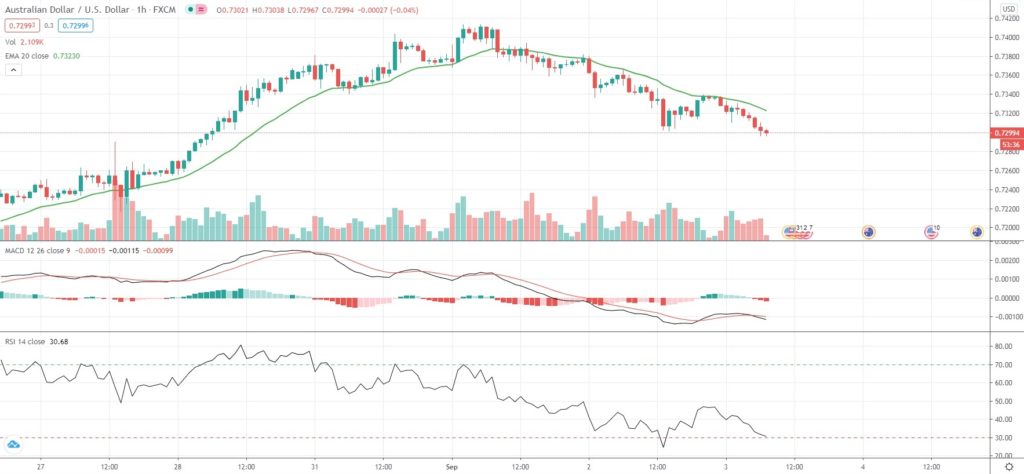AUD/USD extended losses from the prior trading day and registered a one-week low on Thursday, as downbeat Australian services activity and trade data added to pressure, while the US Dollar continued its rebound against major peers.
The latest report by Markit/Commonwealth Bank showed activity in Australia’s sector of services had contracted in August following two straight months of expansion amid renewed coronavirus lockdown restrictions. The respective Services PMI dropped to a final 49.0 in August from 58.2 in July – the highest reading in over three years.
A separate report by the Australian Bureau of Statistics showed the nation’s trade surplus had shrunk to AUD 4.61 billion in July, or at a steeper rate than expected, from AUD 8.15 billion in June. July’s surplus has been the smallest since February.
These data prints were released a day after an official government report revealed the steepest GDP contraction on record in Q2, as Australia’s economy entered the first recession in 30 years. The nation’s GDP shrank 7% on a quarterly basis and 6.3% on yearly basis in Q2.
Meanwhile, the US Dollar Index (DXY) rose for a third straight day, rebounding from Tuesday’s 28-month low, while gaining 0.35% to 92.98.
“You could put (the dollar bounce) down to a bit of a trend reversal, it’s had a long run downwards,” BNZ senior market strategist Jason Wong said.
“But if it is a floor, it’s only a short-term one … everyone’s pretty bearish the dollar for good reason,” Wong added, referring to the Fed’s policy outlook involving low interest rates for a longer time period.
As of 7:02 GMT on Thursday AUD/USD was edging down 0.46% to trade at 0.7303, after earlier touching an intraday low at 0.7297, or its weakest level since August 28th (0.7254). The major pair advanced 3.31% in August, while marking its fifth consecutive month of gains.
In terms of economic calendar, today’s focus will be on US trade balance report, scheduled at 12:30 GMT. The US trade deficit probably widened to USD 58.0 billion in July, according to market expectations, from a deficit figure of USD 50.7 billion in June.
A separate report at 12:30 GMT by the US Labor Department may show the number of people in the country, who filed for unemployment assistance for the first time during the business week ended August 28th, probably eased to 950,000, according to market expectations, from 1,006,000 in the preceding week.
Another report, by the Institute for Supply Management, at 14:00 GMT may show activity in the US sector of services expanded for a third consecutive month in August. The respective Non-Manufacturing Purchasing Managers’ Index is expected to come in at a reading of 57.0, down from 58.1 in July.
And at 17:00 GMT Federal Reserve President for Chicago Charles Evans is scheduled to speak on current economic conditions and monetary policy before the Lakeshore Chamber of Commerce.
Bond Yield Spread
The spread between 2-year Australian and 2-year US bond yields, which reflects the flow of funds in a short term, equaled 12.5 basis points (0.125%) as of 6:15 GMT on Thursday, or unchanged compared to September 2nd.
Daily Pivot Levels (traditional method of calculation)
Central Pivot – 0.7340
R1 – 0.7379
R2 – 0.7420
R3 – 0.7459
R4 – 0.7498
S1 – 0.7298
S2 – 0.7260
S3 – 0.7218
S4 – 0.7177






